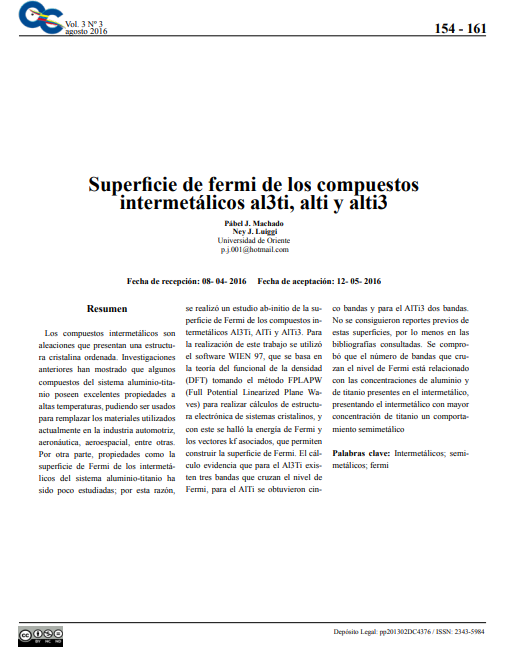Fermi surface of al3ti, alti and alti3 intermetallic compounds
Keywords:
Intermetallic, semi-metallic, fermiAbstract
Intermetallic compounds are alloys with an ordered crystalline structure. Previous research has shown that some compounds of the aluminum-titanium system possess excellent properties at high temperatures, and can be used to replace materials currently used in the automotive, aeronautical, and aerospace industries, among others. On the other hand, properties such as the Fermi surface of the aluminum-titanium system intermetallics have been little studied; for this reason, an ab-initio study of the Fermi surface of the Al3Ti, AlTi and AlTi3 intermetallic compounds was carried out. To carry out this work, the software WIEN 97 was used, which is based on the density functional theory (DFT) taking the FPLAPW method (Full Potential Linearized Plane Waves) to perform electronic structure calculations of crystalline systems, and with it, the Fermi energy and associated kf vectors were found, which allow building the Fermi surface. The calculation shows that for Al3Ti there are three bands that cross the Fermi level, for AlTi five bands were obtained and for AlTi3 two bands. No previous reports of these surfaces were obtained, at least in the bibliographies consulted. It was verified that the number of bands that cross the level of Fermi is related to the concentrations of aluminum and titanium present in the intermetallic, presenting the intermetallic with greater concentration of titanium a semi-metallic behavior.
Downloads
References
Asta M., De Fontaine D., Van Schilfgaarde M., Sluiter M. and Methfessel M. 1992. First-principles phase-stability study of fcc alloys in the Ti-Al system. Physical Review B. 46: 5055 - 5072.
Blaha P., Schwarz K., and Luitz J. 2000. Wien 97 A full potential linearized augmented plane waves package for calculating crystal properties. Technical University of Vienna. Vienna.
Hong T., Watson-Yang T. J., Freeman A. J., Oguchi T. and Jian- Hua X. 1991. Crystal structure, phase stability, and electronic structure of Al-Ti intermetallics: TiAl3. Physical Review B. 41: 12462 – 12467.
Hong T., Watson-Yang T. J., Guo X. J., Freeman A. J., Oguchi T. and Jian-Hua Xu. 1991. Crystal structure, phase stability, and electronic structure of Al-Ti intermetallics: Ti3Al. Physical Review B. 43: 1940 - 1947.
Kittel C. 1996. Introduction to solid state physics. Séptima edición. John Wiley & Sons, Inc. New York.
Kohn W. and Sham L. J. 1965. Self-consistent equations including exchange and correlation effects. Physical Review. 140: 1133 – 1138.
Louks T. L. 1967. Augmented Plane Wave Method. W. A. Benjamin Inc. New York.
Parr R. and Yang W. 1989. Density functional theory of atoms and molecules. Oxford University press, Inc. New York.
Rajendra R. Z. and Mishin Y. 2003. Interatomic potentials for atomistic simulations of the Ti-Al system. Physical Review B. 68: 1 - 14.
Varin R. A. 2000. Intermetallics: Crystal structures. Encyclopedia of Materials: Science

Downloads
Published
How to Cite
Issue
Section
License

This work is licensed under a Creative Commons Attribution-NoDerivatives 4.0 International License.







